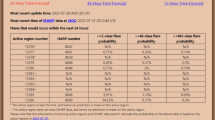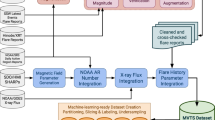Abstract
Flares are powerful bursts of energy released by relatively poorly understood processes that take place in the atmospheres of stars1. However, although solar flares, from our own Sun, are the most energetic events in the solar system, in comparison to the total output of the Sun they are barely noticeable2,3. Consequently, the total amount of radiant energy they generate is not precisely known, and their potential contribution to variations in the total solar irradiance4 incident on the Earth has so far been overlooked. In this work, we identify a measurable signal from relatively moderate solar flares in total solar irradiance data. We find that the total energy radiated by flares exceeds by two orders of magnitude the flare energy radiated in the soft-X-ray domain only, indicating a major contribution in the visible domain. These results have implications for our understanding of solar-flare activity and the variability of our star.
This is a preview of subscription content, access via your institution
Access options
Subscribe to this journal
Receive 12 print issues and online access
$259.00 per year
only $21.58 per issue
Buy this article
- Purchase on SpringerLink
- Instant access to full article PDF
Prices may be subject to local taxes which are calculated during checkout



Similar content being viewed by others
References
Haisch, B., Strong, K. T. & Rodono, M. Flares on the sun and other stars. Annu. Rev. Astron. Astrophys. 29, 257–324 (1991).
Hudson, H. S. & Willson, R. C. Upper limits on the total radiant energy of solar flares. Sol. Phys. 86, 123–130 (1983).
Woods, T. N. et al. Solar irradiance variability during the October 2003 solar storm period. Geophys. Res. Lett. 31, L10802 (2004).
Fröhlich, C. & Lean, J. Solar radiative output and its variability: Evidence and mechanisms. Astron. Astrophys. Rev. 12, 273–320 (2004).
Carrington, R. C. Description of a singular appearance seen in the sun on September 1. Mon. Not. R. Astron. Soc. 20, 13–15 (1859).
Neidig, D. F. The importance of solar white-light flares. Sol. Phys. 121, 261–269 (1989).
Woods, T. N., Kopp, G. & Chamberlin, P. C. Contributions of the solar ultraviolet irradiance to the total solar irradiance during large flares. J. Geophys. Res. 111, A10S14 (2006).
Johnsen, H., Pécseli, H. L. & Trulsen, J. Conditional eddies in plasma turbulence. Phys. Fluids 30, 2239–2254 (1987).
Frohlich, C. et al. First results from VIRGO, the experiment for helioseismology and solar irradiance monitoring on SOHO. Sol. Phys. 170, 1–25 (1997).
Emslie, A. G. et al. Refinements to flare energy estimates: A followup to ‘Energy partition in two solar flare/CME events’. J. Geophys. Res. 110, 11103 (2005).
Acknowledgements
This work has received funding from the European Community’s Seventh Framework Programme (FP7/2007-2013) under the grant agreement No 218816 (SOTERIA project, www.soteria-space.eu). J-F.H., T.D.d.W. and M.K. also acknowledge financial support from the French–Belgian partnership program ‘Tournesol’.
Author information
Authors and Affiliations
Contributions
S.D., S.M., W.S. and J-F.H. were involved in the design of the study. T.D.d.W. was involved in the analysis of the data. M.K. analysed the data and drafted the manuscript. All authors discussed the results and commented on the manuscript.
Corresponding author
Ethics declarations
Competing interests
The authors declare no competing financial interests.
Rights and permissions
About this article
Cite this article
Kretzschmar, M., de Wit, T., Schmutz, W. et al. The effect of flares on total solar irradiance. Nature Phys 6, 690–692 (2010). https://doi.org/10.1038/nphys1741
Received:
Accepted:
Published:
Issue Date:
DOI: https://doi.org/10.1038/nphys1741
This article is cited by
-
Extreme solar events
Living Reviews in Solar Physics (2022)
-
Energy Partition in Four Confined Circular-Ribbon Flares
Solar Physics (2021)
-
Solar Irradiance Variability Due to Solar Flares Observed in Lyman-Alpha Emission
Solar Physics (2021)
-
Extreme Ultra-Violet Spectroscopy of the Lower Solar Atmosphere During Solar Flares (Invited Review)
Solar Physics (2015)
-
Temperature Dependence of the Flare Fluence Scaling Exponent
Solar Physics (2015)



